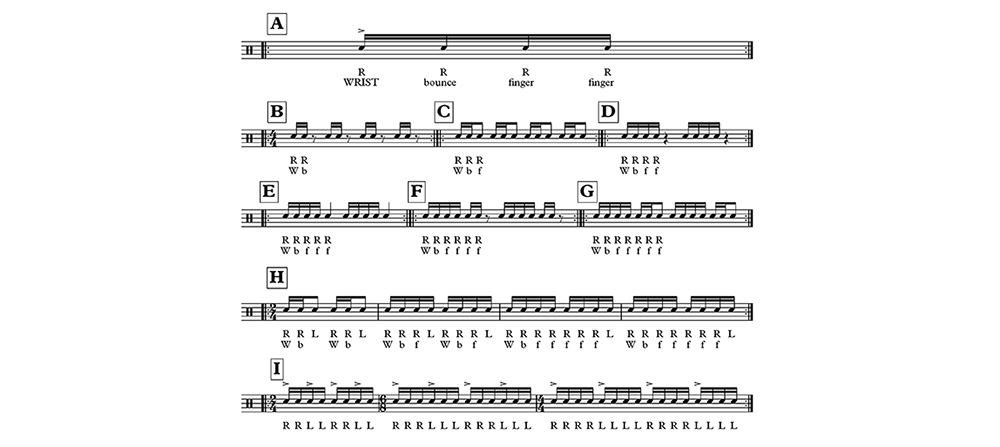To Be Noted
Depending on the school of thought you’ve come from, you’ll have an opinion on how this next part works. Some will say that you should always use the bounce coming from the drum or surface you’re playing. Others will say that sometimes the surface you’re playing on may not have much rebound so therefore, the hands should do all the work at all times. My opinion is smack in the middle of this. If you’re playing on a pad or snare drum, the rebound will be plentiful so you might as well use it! This said, if you move to the floor tom, you’re likely to have a much lower-tuned head that offers less rebound. You’ll have to work harder here. Fortunately, practicing on both surfaces develops muscles and technique accordingly.
Finger Control
When you play a multiple stroke exercise, initially you will have three basic motions – Wrist (the initial stroke), Bounce (the stroke that results from the inertia of the first stroke) and any number of finger strokes – to keep the roll going as long as you need. See Figure A. Finger strokes are literally only the back fingers flicking the stick whilst the thumb and the first finger are stationary, acting as the fulcrum or balance point. As you progress and depending on the surface area you’re playing on, you may be able to eliminate the bounce stroke and go straight into finger strokes but regardless, you need to have the wrist or initial stroke to create enough movement to allow the stick to get moving.
Exercises
Now bear in mind that there are many different approaches to this and as you try some of these exercises, you’ll come up with your own for sure. Check out Figures B – G for some initial exercises playing multiple strokes, adding a stroke each time. The basic goal here is to keep the strokes going without having to play each one individually with the wrist itself. If you can use your fingers, you’re essentially playing the first stroke (flick!) and the stick rebounds back – half the work basically! Finally, remember to practice these exercises with both hands. Figure H is just an extension of the first exercises but uses the opposite hand to fill the gap in the rhythm. This makes the exercise a bit more musical and is better fun to move onto the drums. For example you could play all the multiple strokes on the snare and the single stroke over the toms or vice versa. I’ve used Figures B, C and G for this. You can experiment further though.
The last exercise (FIG I) is a cool one to get happening. It uses multiple strokes in each hand and increases by one stroke each bar. I’ve only notated to 4 strokes per hand but you should continue onwards maintaining the 16th stroke subdivision. There will be odd time signatures. Don’t be afraid!
Apply Technique To Rudiments
The last point to note here relates to my initial opening statement about rudiments. How’s it related you ask? If you can play multiple strokes in each hand and you can maintain finger control, you’re essentially just doing one side of a single stroke roll. Doing the same technique with both hands alternating gives you a single stroke roll that can be played at a variety of dynamic levels. Further, if you’re so good now at playing four, five, eight strokes a bar etc. then two should be a breeze and you’ll find your double stroke roll is not only more even but also less labouring. Then by adding that little finger stroke technique into the middle of the paradiddle (on the double stroke) you’ll be able to speed this up too. Winning!

